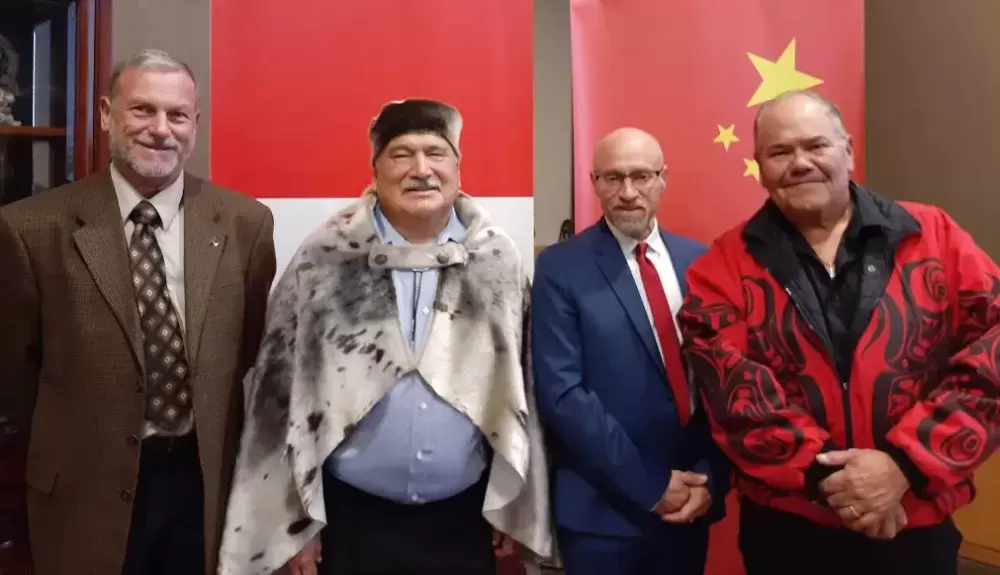A First Nations group pressing for a coastwide commercial harvest of seals and sea lions has partnered with taxidermist FurCanada and met with Chinese consular officials to explore market opportunities.
All the same, a Kwakwaka-wakw consultant and eco-tourism operator who has spearheaded the initiative says he’s frustrated by a lack of formal support from coastal First Nations.
“We definitely have a response (from DFO), but there are a bunch of hurdles,” said Thomas Sewid of Pacific Balance Marine Management (PBMM). “One of the greatest roadblocks right now is First Nations participation. We need every First Nation to send a letter of support.”
For the past 18 months, PBMM has promoted potential for an Indigenous commercial fishery of seals and sea lions (collectively known as pinnipeds) above and beyond food, social and ceremonial catches. PBMM supporters point to a population explosion of pinnipeds taking a huge bite out of declining wild salmon stocks.
First aligning under the banner of the Pacific Balance Pinniped Society, the group began lobbying DFO and building support two years ago before First Nation members broke away to form PBMM. Sewid has teamed with Roy Jones Jr., a Haida hereditary chief, and said he has widespread support from First Nations along the B.C. coast.
“We have all the bases covered for First Nations to step up and get a new industry going,” Sewid said. “We’ve had a lot of Nuu-chah-nulth support. We just haven’t seen anything in writing.”
He said PBMM is working “on a limited basis” with DFO to see First Nations obtain licenses to sell seal and sea lion parts harvested under their existing food, social and ceremonial rights. He feels, however, that the effort will be wasted unless they hear from First Nations soon.
Archie Little, a Nuchatlaht councillor, said there has been discussion on the issue.
“We met with Roy Jones of Haida Gwaii. We met in Nanaimo a year ago and we gave full support,” Little said.
Little isn’t sure that a commercial harvest is the solution to finfish decline, yet he is certain something must be done.
“There’s lots to this and it’s not just seals and sea lions,” he cautioned, citing the Nuu-chah-nulth philosophy, hishuk’ish tsawalk, everything is connected. “We need to step back a bit to focus on what we need to do. Things have moved so far out of balance.”
Roger Dunlop, Uu-a-thluk northern region biologist, said that fly-over detection of pinniped numbers would improve understanding of population trends. Ocean productivity across all species has fallen 20 percent due to climate warming while people are not harvesting seals and sea lions as they once did, he noted.
“The question you’ve got to ask is which species is guilty,” Dunlop said. “You can’t just go out, like this group is saying, and reduce them.”
Mowachaht/Muchalaht First Nation has received DFO approval for funding to track seals, which have been increasing in numbers in rivers along the Island’s northwest coast. That work may take place this winter.
“There’s definitely interest,” Dunlop added. Another key question, from a Nuu-chah-nulth perspective, is sustainability. “Now we have to find money to fly around and count them.”
“We’ll probably work with DFO collaboratively and figure out what to do,” he added.
Dunlop agrees that there has been a major resurgence of pinnipeds since they were officially protected and slaughter was halted in 1970. UBC fisheries scientist Carl Walters identified the population concern years ago, he said.
Evaluating the PBMM proposal, Walters presented data last spring showing a tenfold increase in seal populations and a threefold increase in sea lions in B.C. waters. Walters suggests the only way to effectively determine the impact on salmon would be an experimental reduction in pinnipeds to see if chinook rebound.
DFO seems more interested now in the possibility of a pinniped commercial harvest, Dunlop noted.
“The question is, politically, does the public want to tolerate it or not,” he asked.
Harbour seals are most concentrated in the Salish Sea while First Nations along the Island’s northwest coast are faced with another population explosion, that of sea otters. The species was reintroduced in the late 1970s without Indigenous consultation and have an impact on shellfish beds. There are about 5,000 sea otters now along the west coast, yet they remain listed as a species of concern. DFO will not allow more than a minor harvest for cultural purposes until the species is re-established coast-wide, Dunlop said.
Asked for an update on the pinniped proposal, a DFO spokeswoman said the department is working with academic partners and U.S. counterparts to convene a second expert workshop “to summarize what is known about potential impacts of pinniped predation on salmon, with a focus on the Salish Sea.”
Seal and sea lion populations grew exponentially in the 1970s and ’80s, but growth rates began to slow in the 1990s according to DFO biologist Tucker Strahan of the pinniped research program based in Nanaimo. Steller sea lion populations continue to increase. California sea lions have increasingly over-wintered in B.C. waters in the last 30 years and number about 10,000.
Many who fish along the coast argue that the situation is out of control with pinnipeds taking a greater share of dwindling fish stocks, often interfering with fishery activities. Conservation groups counter that a pinniped harvest would not benefit wild salmon.
Sewid is well aware of politics that make the proposal contentious. If they can’t secure a commercial harvest, he expects more pinnipeds will be illegally shot by fishermen.
“We have a salmon disaster and we have a herring disaster and yet they can’t get anyone who wants to pick up a gun and shoot a sea lion,” he said. “I see us shooting ourselves in the foot.”
Little feels it is time for Nuu-chah-nulth leaders to strategize on the issue.
“It’s huge and we haven’t done anything about it,” Little said. “I think the chiefs should get together with a solution and a plan, not just to talk about it.”

